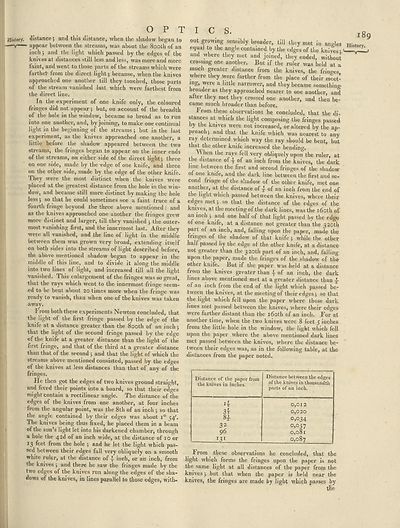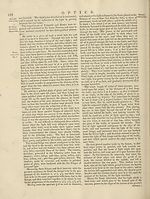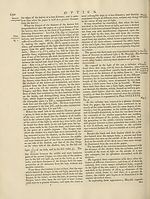Encyclopaedia Britannica > Volume 15, NIC-PAR
(209) Page 189
Download files
Complete book:
Individual page:
Thumbnail gallery: Grid view | List view

OPTICS.
History, distance; and this distance, when the shadow began to
■— v""— appear between the streams, was about the Sooth of an
inch ; and the light which passed by the edges of the
knives at distances still less and less, was more and more
faint, and went to those parts of the streams which were
farthel- from the direct light; because, when the knives
approached one another till they touched, those parts
of the stream vanished last which were farthest from
the direct line.
In the experiment of one knife only, the coloured
fringes did not appear; but, on account of the breadth
of the hole in the window, became so broad as to run
into one another, and, by joining, to make one continual
light in the beginning of the streams; but in the last
experiment, as the knives approached one another, a
little before the shadow appeared between the two
streams, the fringes began to appear on the inner ends
of the streams, on either side of the direct light; three
on one side, made by the edge of one knife, and three
on the other side, made by the edge of the other knife.
They were the most distinct when the knives were
placed at the gi'eatest distance from the hole in the win¬
dow, and became still more distinct by making the hole
less; so that he could sometimes see a faint trace of a
fourth fringe beyond the three above mentioned: and
as the knives approached one another the fringes grew
more distinct and larger, till they vanished ; the outer¬
most vanishing first, and the innermost last. After they
were all vanished, and the line of light in the middle
between them was grown very broad, extending itself
on both sides into the streams of light described before,
the above mentioned shadow began to appear in the
middle of this line, and to divide it along the middle
into two lines of light, and increased till all the light
vanished. This enlargement of the fringes was so great,
that the rays which went to the innermost fringe seem¬
ed to be bent about 20 times more when the fringe was
ready to vanish, than when one of the knives was taken
away.
From both these experiments Newton concluded, that
the light of the first fringe passed by the edge of the
knife at a distance greater than the Sooth of an inch ;
that the light of the second fringe passed by the edge
of the knife at a greater distance than the light of the
first fringe, and that of the third at a greater distance
than that of the second ; and that the light of which the
streams above mentioned consisted, passed by the edges
of the knives at less distances than that of any of the
fringes.
He then got the edges of two knives ground straight,
and fixed their points into a hoax'd, so that their edges
might contain a rectilinear angle. The distance of the
edges of the knives from one another, at four inches
from the angular point, was the 8th of an inch ; so that
the angle contained by their edges was about i° 5V.
The knives being thus fixed, he placed them in a beam
of the sun’s light let into his darkened chamber, through
a hole the 42d of an inch wide, at the distance of 10 or
13 feet from the hole ; and he let the light which pas¬
sed between their edges fall very obliquely on a smooth
white ruler, at the distance of 4 inch, or an inch, from
the knives ; and thei’e he saw the fringes made by the
two edges ot the knives run along the edges of the sha¬
dows of the knives, in lines parallel to those edges, with¬
out growing sensibly broader, till they met in angles
equal to the angle contained by the edges of the knives-
and where they met and joined, they ended, without
crossing one another. But if the ruler was held at a
much greater distance from the knives, the fringes
where they were farther from the place of their meet^
ing, were a little narrower, and they became something-
broader as they approached nearer to one another, and
after they met they crossed one another, and then be¬
came much broader than before.
I rom these observations he concluded, that the di¬
stances at which the light composing the fringes passed
by the knives were not increased, or altered by the ap¬
proach; and that the knife which was nearest to any
ray determined which way the ray should be bent, but
that the other knife increased the bending.
’Uhen the rays fell very obliquely upon the ruler, at
the distance of | of an inch from the knives, the dark
line between the first and second fringes of the shadow
0 one and the dark line between the first and se¬
cond fringe of the shadow of the other knife, met one
another, at the distance of 4 of an inch from the end of
toe light which passed between the knives, where their
edges met; so that the distance of the edges of the
knives, at the meeting of the dark lines, was the 160th of
an inch ; and one half of that light passed by the edge
of one knife, at a distance not greater than the 320th
part of an inch, and, falling upon the paper, made the
fringes of the shadow of that knife ; while the other
half passed by the edge of the other knife, at a distance
not greater than the 320th part of an inch, and, falling
upon the paper, made the fringes of the shadow of the
other knife. But if the paper was held at a distance
from the knives greater than 4 of an inch, the dark
lines above mentioned met at a greater distance than 4
of an inch from the end of the light which passed be¬
tween the knives, at the meeting of their edges; so that
the light which fell upon the paper where those dark
lines met passed between the knives, where their edges
were farther distant than the 160th of an inch. For at
another time, when the two knives were 8 feet 5 inches
from the little hole in the window, tile light which fell
upon the paper where the above mentioned dark lines
met passed between the knives, where the distance be¬
tween their edges was, as in the following table, at the
distances from the paper noted.
Distance of the paper from
the knives in inches.
3t
84
32
96
!3i
Distance between the edges
of the knives in thousandth
parts of an inch.
0,012
0,020
0,034
0,057
0,o8l
0,087
From these observations he concluded, that the
fight which forms the fringes upon the paper is not
the same light at all distances of the paper from the
knives; but that when the paper is held near the
knives, the fringes are made by light which passes by
the
History, distance; and this distance, when the shadow began to
■— v""— appear between the streams, was about the Sooth of an
inch ; and the light which passed by the edges of the
knives at distances still less and less, was more and more
faint, and went to those parts of the streams which were
farthel- from the direct light; because, when the knives
approached one another till they touched, those parts
of the stream vanished last which were farthest from
the direct line.
In the experiment of one knife only, the coloured
fringes did not appear; but, on account of the breadth
of the hole in the window, became so broad as to run
into one another, and, by joining, to make one continual
light in the beginning of the streams; but in the last
experiment, as the knives approached one another, a
little before the shadow appeared between the two
streams, the fringes began to appear on the inner ends
of the streams, on either side of the direct light; three
on one side, made by the edge of one knife, and three
on the other side, made by the edge of the other knife.
They were the most distinct when the knives were
placed at the gi'eatest distance from the hole in the win¬
dow, and became still more distinct by making the hole
less; so that he could sometimes see a faint trace of a
fourth fringe beyond the three above mentioned: and
as the knives approached one another the fringes grew
more distinct and larger, till they vanished ; the outer¬
most vanishing first, and the innermost last. After they
were all vanished, and the line of light in the middle
between them was grown very broad, extending itself
on both sides into the streams of light described before,
the above mentioned shadow began to appear in the
middle of this line, and to divide it along the middle
into two lines of light, and increased till all the light
vanished. This enlargement of the fringes was so great,
that the rays which went to the innermost fringe seem¬
ed to be bent about 20 times more when the fringe was
ready to vanish, than when one of the knives was taken
away.
From both these experiments Newton concluded, that
the light of the first fringe passed by the edge of the
knife at a distance greater than the Sooth of an inch ;
that the light of the second fringe passed by the edge
of the knife at a greater distance than the light of the
first fringe, and that of the third at a greater distance
than that of the second ; and that the light of which the
streams above mentioned consisted, passed by the edges
of the knives at less distances than that of any of the
fringes.
He then got the edges of two knives ground straight,
and fixed their points into a hoax'd, so that their edges
might contain a rectilinear angle. The distance of the
edges of the knives from one another, at four inches
from the angular point, was the 8th of an inch ; so that
the angle contained by their edges was about i° 5V.
The knives being thus fixed, he placed them in a beam
of the sun’s light let into his darkened chamber, through
a hole the 42d of an inch wide, at the distance of 10 or
13 feet from the hole ; and he let the light which pas¬
sed between their edges fall very obliquely on a smooth
white ruler, at the distance of 4 inch, or an inch, from
the knives ; and thei’e he saw the fringes made by the
two edges ot the knives run along the edges of the sha¬
dows of the knives, in lines parallel to those edges, with¬
out growing sensibly broader, till they met in angles
equal to the angle contained by the edges of the knives-
and where they met and joined, they ended, without
crossing one another. But if the ruler was held at a
much greater distance from the knives, the fringes
where they were farther from the place of their meet^
ing, were a little narrower, and they became something-
broader as they approached nearer to one another, and
after they met they crossed one another, and then be¬
came much broader than before.
I rom these observations he concluded, that the di¬
stances at which the light composing the fringes passed
by the knives were not increased, or altered by the ap¬
proach; and that the knife which was nearest to any
ray determined which way the ray should be bent, but
that the other knife increased the bending.
’Uhen the rays fell very obliquely upon the ruler, at
the distance of | of an inch from the knives, the dark
line between the first and second fringes of the shadow
0 one and the dark line between the first and se¬
cond fringe of the shadow of the other knife, met one
another, at the distance of 4 of an inch from the end of
toe light which passed between the knives, where their
edges met; so that the distance of the edges of the
knives, at the meeting of the dark lines, was the 160th of
an inch ; and one half of that light passed by the edge
of one knife, at a distance not greater than the 320th
part of an inch, and, falling upon the paper, made the
fringes of the shadow of that knife ; while the other
half passed by the edge of the other knife, at a distance
not greater than the 320th part of an inch, and, falling
upon the paper, made the fringes of the shadow of the
other knife. But if the paper was held at a distance
from the knives greater than 4 of an inch, the dark
lines above mentioned met at a greater distance than 4
of an inch from the end of the light which passed be¬
tween the knives, at the meeting of their edges; so that
the light which fell upon the paper where those dark
lines met passed between the knives, where their edges
were farther distant than the 160th of an inch. For at
another time, when the two knives were 8 feet 5 inches
from the little hole in the window, tile light which fell
upon the paper where the above mentioned dark lines
met passed between the knives, where the distance be¬
tween their edges was, as in the following table, at the
distances from the paper noted.
Distance of the paper from
the knives in inches.
3t
84
32
96
!3i
Distance between the edges
of the knives in thousandth
parts of an inch.
0,012
0,020
0,034
0,057
0,o8l
0,087
From these observations he concluded, that the
fight which forms the fringes upon the paper is not
the same light at all distances of the paper from the
knives; but that when the paper is held near the
knives, the fringes are made by light which passes by
the
Set display mode to:
![]() Universal Viewer |
Universal Viewer | ![]() Mirador |
Large image | Transcription
Mirador |
Large image | Transcription
Images and transcriptions on this page, including medium image downloads, may be used under the Creative Commons Attribution 4.0 International Licence unless otherwise stated. ![]()
| Encyclopaedia Britannica > Encyclopaedia Britannica > Volume 15, NIC-PAR > (209) Page 189 |
|---|
| Permanent URL | https://digital.nls.uk/192584415 |
|---|
| Attribution and copyright: |
|
|---|
| Shelfmark | EB.11 |
|---|---|
| Description | Ten editions of 'Encyclopaedia Britannica', issued from 1768-1903, in 231 volumes. Originally issued in 100 weekly parts (3 volumes) between 1768 and 1771 by publishers: Colin Macfarquhar and Andrew Bell (Edinburgh); editor: William Smellie: engraver: Andrew Bell. Expanded editions in the 19th century featured more volumes and contributions from leading experts in their fields. Managed and published in Edinburgh up to the 9th edition (25 volumes, from 1875-1889); the 10th edition (1902-1903) re-issued the 9th edition, with 11 supplementary volumes. |
|---|---|
| Additional NLS resources: |
|

